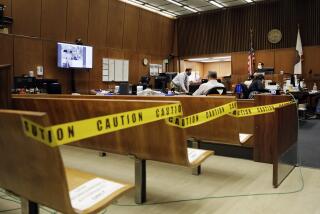Videoconferences Ease Access to Parole Hearings
Eugene Hill appeared before a parole board at Centinela State Prison last month, trying to convince the panel that he no longer posed a danger to the community and deserved to be released.
More than 200 miles away, a Los Angeles County prosecutor argued that Hill had shot his estranged wife and should remain behind bars.
Deputy Dist. Atty. David Barkhurst appeared at the hearing by videoconference, which county officials said saves the county time and money. The technology also allows victims to avoid the expense of traveling to remote state prisons to testify at the hearings.
“For the average person who is working to make ends meet, travel to Susanville or the San Joaquin Valley is an expensive proposition,” said Dave Dahle, who runs the Lifer Hearings Division for the district attorney’s office.
Los Angeles County prosecutors appear at about 2,000 hearings each year at such prisons as Ironwood in Blythe and Corcoran in the Central Valley, trying to block paroles of inmates who are a risk to public safety.
“We’ve got a big stake in making sure someone who is dangerous isn’t released back into the population,” Dahle said. “There are inmates that we do not oppose getting paroled, but they are few and far between.”
The district attorney’s office started participating in parole hearings via video in late 2002, and now prosecutors use the technology for about 10% of hearings. So far this year, prosecutors have spoken at more than 100 video parole hearings from the two county locations -- in Lynwood and downtown Los Angeles -- equipped with the technology. A third site is scheduled to open in Santa Monica this fall.
In the past, Dahle said, he had trouble recruiting deputy district attorneys to participate in the hearings.
But now, he said, it is much easier because the video hearings require no travel.
“It’s a lot more convenient,” said Barkhurst, who added that he would have been reluctant to help if required to be away from the office for three days. “After this is over, I can continue working on my cases.”
Every year, the state Board of Prison Terms conducts about 4,500 to 5,000 parole hearings throughout California.
Board spokesman Tip Kindel said the number of video hearings has risen dramatically, from 79 in 2002 to 431 last year. There were 264 hearings in the first five months of this year.
In addition to helping counties in tough budgetary times, the electronic hearings aid victims, many of whom are reluctant to speak at hearings, Kindel said.
“For some of them who are really sensitive about being in the same room, or even the same building, with the offender, this solves the problem,” Kindel said.
Every year, Cheri Davidson speaks at the parole hearing for Milo Strausbaugh, who was convicted of murdering her brother in 1979.
“We do not want this person out,” she said. “He is a threat not only to our family, but to the community.”
Last year, they appeared at the hearing via San Diego’s videoconference center. But this year, they had to drive to Chuckawalla Valley State Prison in Blythe because the equipment wasn’t working. The board denied parole earlier this month.
Cheri Davidson said she feels safer and more comfortable making her statement at the videoconference center than at the prison. “It’s not as intimidating as face to face,” she said.
Going to downtown San Diego also is more convenient, she said. “It’s an expense and hardship for families to go to the prisons, because these prisons are so far away.”
The San Diego County district attorney’s office, the first to use the video technology for parole hearings, spearheaded legislation that made it possible, said Richard Sachs, who heads the Lifer Hearing Unit.
Although Sachs said it often is more persuasive to have a prosecutor or victim appear in person, “the cost savings and the emotional trauma savings outweigh that one benefit.” Dahle agreed, saying that the only downside to the video hearings is that participants can’t see the same sort of detail they can in person.
In the Eugene Hill case, a Los Angeles County judge sentenced him to prison after he tried to murder his estranged wife on Aug. 28, 1988. He drove to her apartment with a loaded gun and shot her in the stomach.
During last month’s hearing, he acknowledged his responsibility for his wife’s injuries, but said he did not mean to hurt her.
“What happened 16 years ago is very sad, something I regret,” he told the panel. “I know in my lifetime it would never happen again.”
Hill, 55, said he plans to start a business if he is released. “All I want is my freedom,” he said. “I’m no threat to anyone.”
Barkhurst countered that Hill had gone to the apartment, with a gun, to confront his wife and her new boyfriend -- clear indications that the crime was premeditated. Barkhurst said Hill has an “extreme problem” with anger management and has not made a strong effort to rehabilitate himself in prison.
The board denied parole, saying that Hill still posed a “danger to public safety.”
As with any new technology, Kindel said that not all videoconference hearings have gone smoothly. One parole hearing, he said, was interrupted after a sandstorm caused the phone line to go dead.
“Most of the time, it’s really reliable,” he said. “With anything, you can really run into some glitches.”
More to Read
Sign up for Essential California
The most important California stories and recommendations in your inbox every morning.
You may occasionally receive promotional content from the Los Angeles Times.










